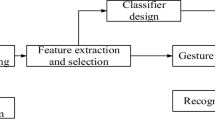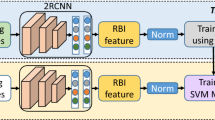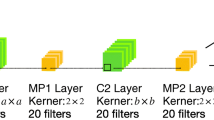Abstract
With the iterative update of computer technology, the penetration of computer and other Internet technologies in human–computer interaction systems has become more and more extensive, and the human–computer interaction methods have quietly undergone huge changes. Gesture recognition has gradually become a hot spot in the field of human–computer interaction now, which has a wide range of application prospects and research value. The color segmentation experiment shows that the skin color of the gesture in the YCrCg space has better clustering properties than in the YCrCb space. In the preprocessing of gesture images, an improved Otsu method is proposed to improve the real-time performance to realize the threshold segmentation of the human hand; then the morphological processing is carried out, and the median filter method is used to achieve image denoising to improve image quality. A gesture recognition algorithm is designed: First, use Graph-SAGE to recognize the graph-structured data of the gesture, and then use the Adaboost algorithm to combine the two strong classifiers of the random forest and the support vector machine into a cascade classifier through the cascade structure. The output information of Graph-SAGE is classified and the meaning of the gesture is analyzed. On the test set, the average detection accuracy of the algorithm is 91.70%, the recall rate is 94.23%, and the average detection time per frame is 330 ms.








Similar content being viewed by others
Explore related subjects
Discover the latest articles, news and stories from top researchers in related subjects.References
Can C, Kaya Y, Kilic F. (2021). A deep convolutional neural network model for hand gesture recognition in 2D near-infrared images[J]. Biomed Phys Eng Expr. 7(5)
Guler O, Yucedag I (2021) Hand gesture recognition from 2d images by using convolutional capsule neural networks [J]. Arabian J Sci Eng. 7(prepublish)
Osman GY (2021) Hand gesture recognition from 2D images by using convolutional capsule neural networks[J]. Arab J Sci Eng 390(65):342–349
Yuting L, Jiang D, Haojie D, Ying S, Gongfa L, Bo T, Juntong Y, Ying L, Baojia C (2021) Dynamic gesture recognition algorithm based on 3D convolutional neural network [J]. Comput Intellig Neurosci. 8(17):1–12
Han L, Runyuan G (2018) Detection and identification of sawh pipe weld defects based on X-ray image and CNN. Chinese Journal of Scientific Instrument 39(4):247–256
Fuqing Z, Xiangwei K, Haiyan F (2018) A Novel Two-stream saliency image fusion CNN architecture for person re-identification. Multim Syst. 24(5):569–582
Liang-Chieh C, George P, Iasonas K (2018) Deeplab: semantic image segmentation with deep convolutional nets, atrous convolution, and fully connected Crfs. IEEE Trans Pattern Anal Mach Intell 40(4):834–848
Changqing L, Bingqi C (2014) Method of image detection for ear of corn based on computer vision. Trans Chinese Soc Agricult Eng. 30(6):131–138
Hu TH, Wan L, Liu TA (2017) Advantages and application prospects of deep learning in image recognition and bone age assessment. J Forensic Med 33(6):629–634
Diego O, Erik C, Gonzalo P (2014) Template matching using an improved electromagnetism-like algorithm. Appl Intell 41(3):791–807
Li Shiwu Xu, Yi SW (2014) Remote sensing image recognition for vehicles based on self-feedback template extraction. J South China Univ Technol 42(5):97–102
Gang Wang, Xiaoliang Sun, Yang Shang (2017) A robust template matching algorithm based on best-buddies similarity. Acta Optica Sinica 37(3):0315003
Fukumoto M, Mase K, Suenaga Y (1999) Real-time detection of pointing actions for a glove-free interface.in IAPR workshop on machine vision applications. 473–476
Cipolla R, Okamoto Y, Kuno Y (1993) Robust structure from motion using motion parallax. In: IEEE 4th International Conference on Computer Vision. 374–382
Belaroussi R, Milgram M (2014) Visual gesture recognition. IEE Proc Vis Image and Signal Proc. 141(2):101–106
Ratha Pech, Dong Hao, Liming Pan (2017) Link prediction via matrix completion [J]. EPL. 117(3):38002
Yang C, Liu Z, Zhao D et al (2015). Network representation learning with rich text information[C], Twenty-Fourth. In: International Joint Conference on Artificial Intelligence. 2111–2117.
Perozzi B, Al-Rfou R, Skiena S. (2014). Deepwalk: Online learning of social representations[C]. In: Proceedings of the 20th ACM SIGKDD international conference on Knowledge discovery and datamining. 701–710.
Acknowledgments
The study was supported by “Tianjin science and technology project (Grant No. 21YDTPJC00050)” and “science and technology on electro-optical information security control laboratury project (Grant No. 2021JCJQLB055008)”.
Author information
Authors and Affiliations
Corresponding author
Ethics declarations
Conflict of interest
The authors have no competing interests.
Additional information
Publisher's Note
Springer Nature remains neutral with regard to jurisdictional claims in published maps and institutional affiliations.
Rights and permissions
About this article
Cite this article
Chen, H., Zhao, H., Qi, B. et al. Gesture recognition of graph convolutional neural network based on spatial domain. Neural Comput & Applic 35, 2157–2167 (2023). https://doi.org/10.1007/s00521-022-07040-8
Received:
Accepted:
Published:
Issue Date:
DOI: https://doi.org/10.1007/s00521-022-07040-8




